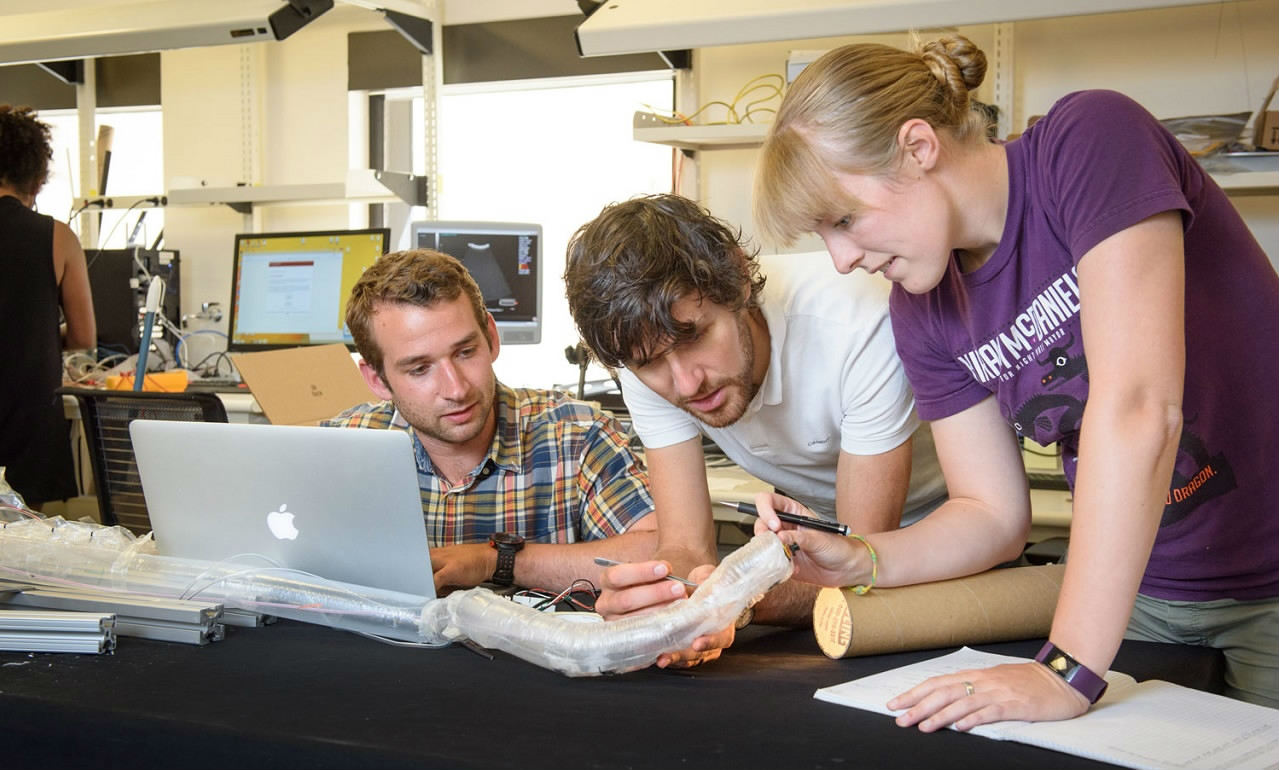


CGTN photo
Inspired by natural organisms that cover significant distances by growing, such as vines, fungi and nerve cells, mechanical engineers at Stanford University have created a new type of robot that can grow across distances without moving its whole body.

The vine–like robot is a tube of soft material that grows in one direction. /Photo via Stanford University
"Essentially, we're trying to understand the fundamentals of this new approach to getting mobility or movement out of a mechanism," explained Allison Okamura, professor of mechanical engineering and senior author of a paper published on Wednesday in journal Science Robotics.
"It's very, very different from the way that animals or people get around the world."
The basic idea behind this robot is straightforward. It's a tube of soft material folded inside itself, like an inside–out sock, that grows in one direction when the material at the front of the tube everts, as the tube becomes right–side–out.
To investigate what their robot can do, the group created prototypes that move through various obstacles, travel toward a designated goal, and grow into a freestanding structure. In the prototypes, the material was a thin, cheap plastic and the robot body everted when the researchers pumped pressurized air into the stationary end.
In testings, the research group tried to move the robot from one place to another in several ways. It grew through an obstacle course, where it traveled over flypaper, sticky glue and nails and up an ice wall to deliver a sensor. It completed the course even though it was punctured by the nails because the area that was punctured didn't continue to move and, as a result, self-sealed by staying on top of the nail.
A primary advantage of soft robots is that they can be safer than hard, rigid robots not only because they are soft but also because they are often lightweight. Another benefit, in the case of this robot, is that it is flexible and can follow complicated paths.
"The body lengthens as the material extends from the end but the rest of the body doesn't move," noted Elliot Hawkes, a visiting assistant professor from the University of California, Santa Barbara, and lead author of the paper. "The body can be stuck to the environment or jammed between rocks, but that doesn't stop the robot because the tip can continue to progress as new material is added to the end."
Some iterations of these robots included a control system that differentially inflated the body, which made the robot turn right or left. The researchers developed a software system that based direction decisions on images coming in from a camera at the tip of the robot.

Graduate students Joseph Greer (left) and Laura Blumenschein (right) work with Elliot Hawkes, a visiting assistant professor from the University of California, Santa Barbara, on a prototype of the "vinebot". /Photo via Stanford University
Joey Greer, a graduate student in the Okamura lab and co-author of the paper, was quoted as saying in a news release that controlling a robot requires a precise model of its motion, which is difficult to establish for a soft robot.
"Also, using a camera to guide the robot to a target is a difficult problem because the camera imagery needs to be processed at the rate it is produced. A lot of work went into designing algorithms that both ran fast and produced results that were accurate enough for controlling the soft robot."
In the future, the researchers would like to create versions that may also grow using liquid, which could help deliver water to people trapped in tight spaces or to put out fires in closed rooms, and possibly with new, tougher materials, like rip-stop nylon and Kevlar. In addition, they hope to scale the robot much larger and much smaller to see how it performs.
(Source: Xinhua)

 Award-winning photos show poverty reduction achievements in NE China's Jilin province
Award-winning photos show poverty reduction achievements in NE China's Jilin province People dance to greet advent of New Year in Ameiqituo Town, Guizhou
People dance to greet advent of New Year in Ameiqituo Town, Guizhou Fire brigade in Shanghai holds group wedding
Fire brigade in Shanghai holds group wedding Tourists enjoy ice sculptures in Datan Town, north China
Tourists enjoy ice sculptures in Datan Town, north China Sunset scenery of Dayan Pagoda in Xi'an
Sunset scenery of Dayan Pagoda in Xi'an Tourists have fun at scenic spot in Nanlong Town, NW China
Tourists have fun at scenic spot in Nanlong Town, NW China Harbin attracts tourists by making best use of ice in winter
Harbin attracts tourists by making best use of ice in winter In pics: FIS Alpine Ski Women's World Cup Slalom
In pics: FIS Alpine Ski Women's World Cup Slalom Black-necked cranes rest at reservoir in Lhunzhub County, Lhasa
Black-necked cranes rest at reservoir in Lhunzhub County, Lhasa China's FAST telescope will be available to foreign scientists in April
China's FAST telescope will be available to foreign scientists in April